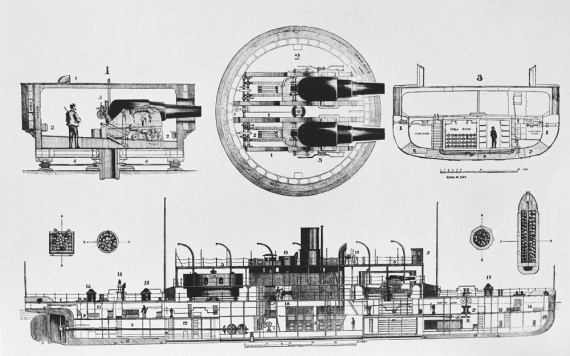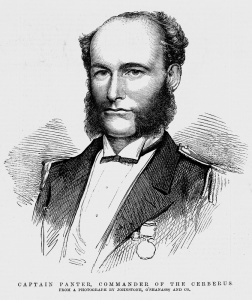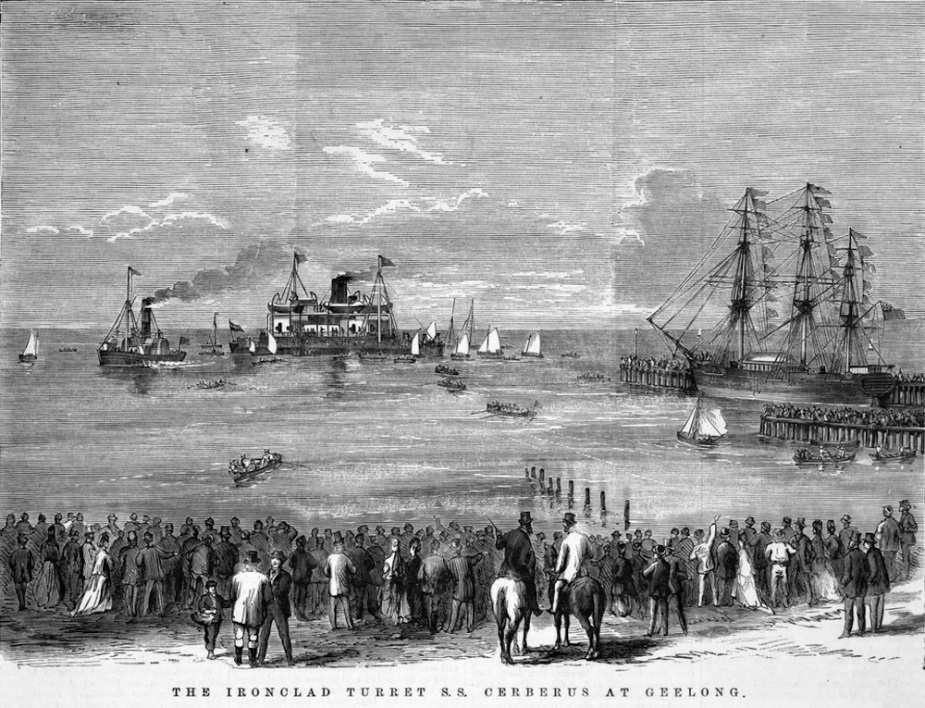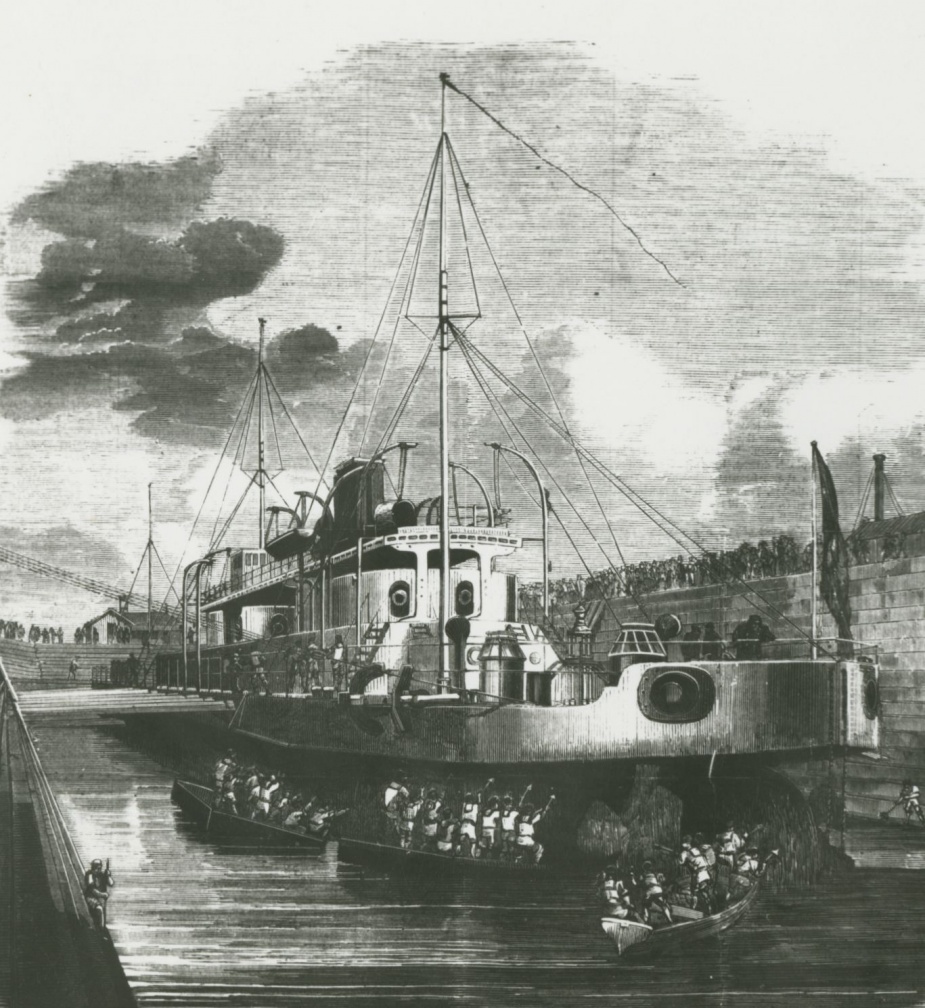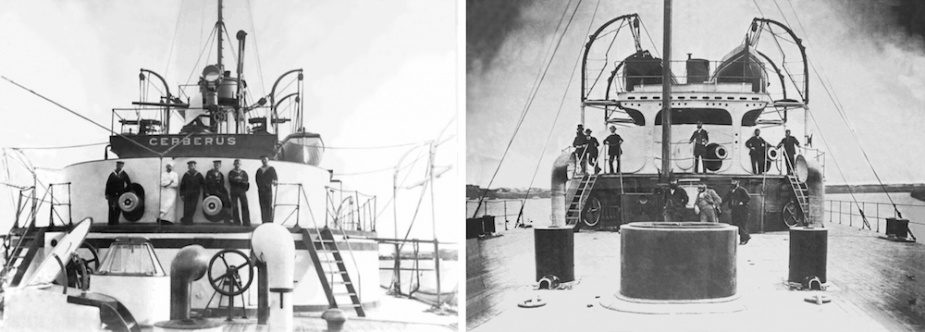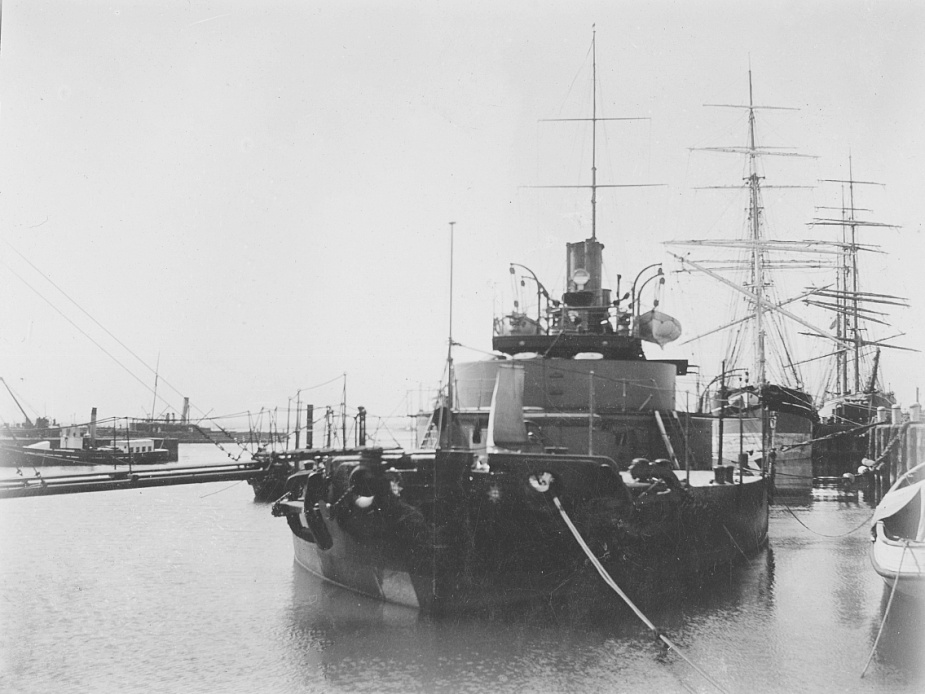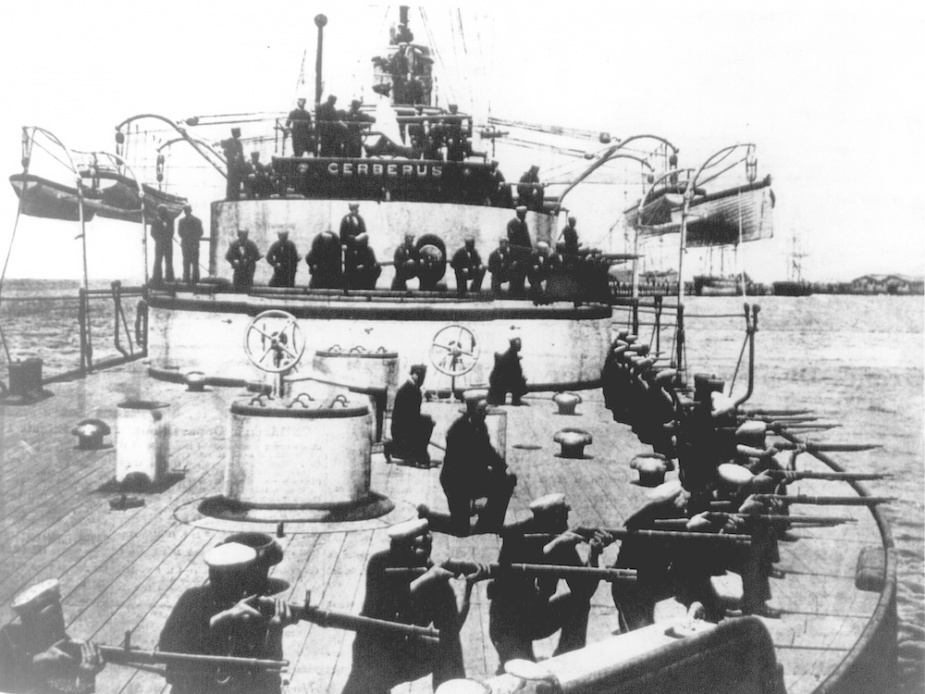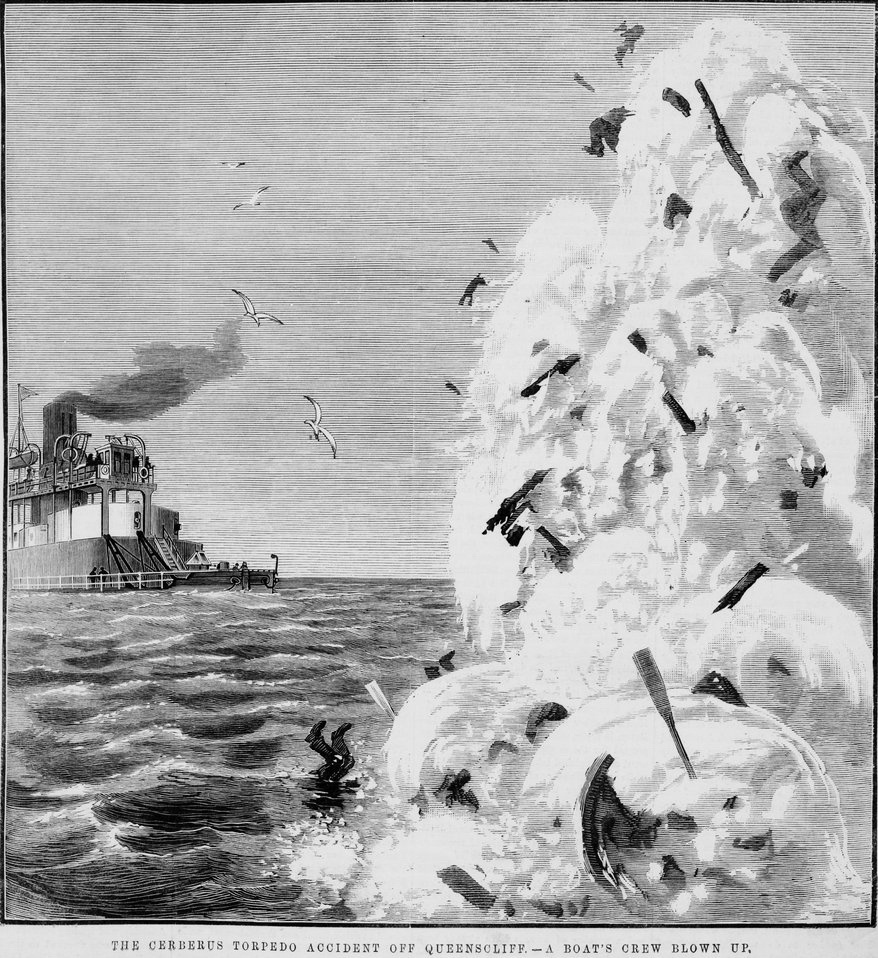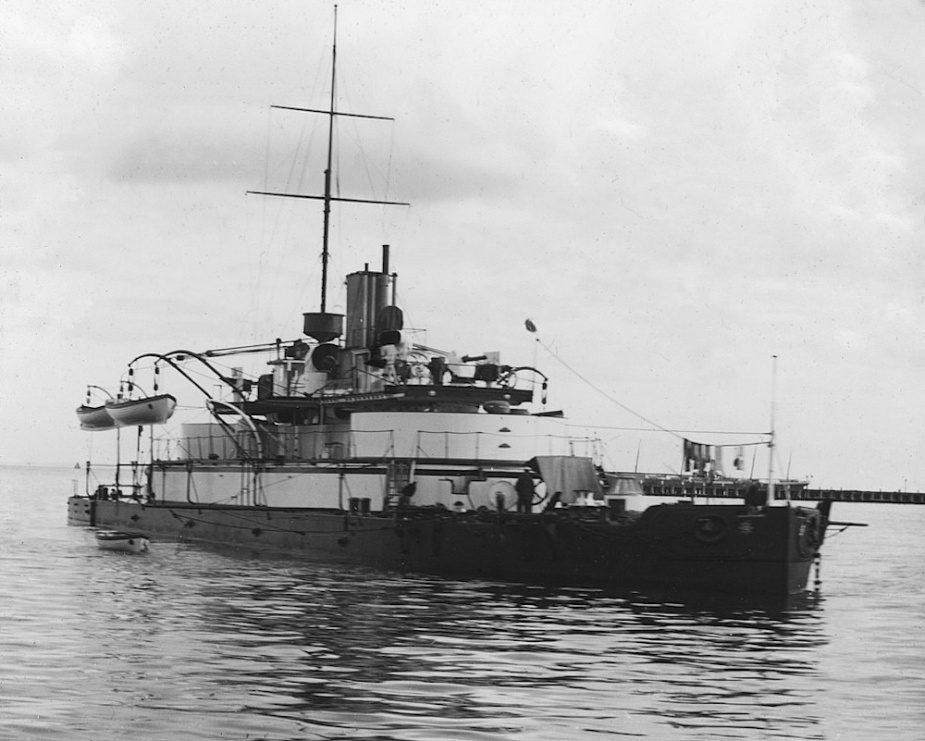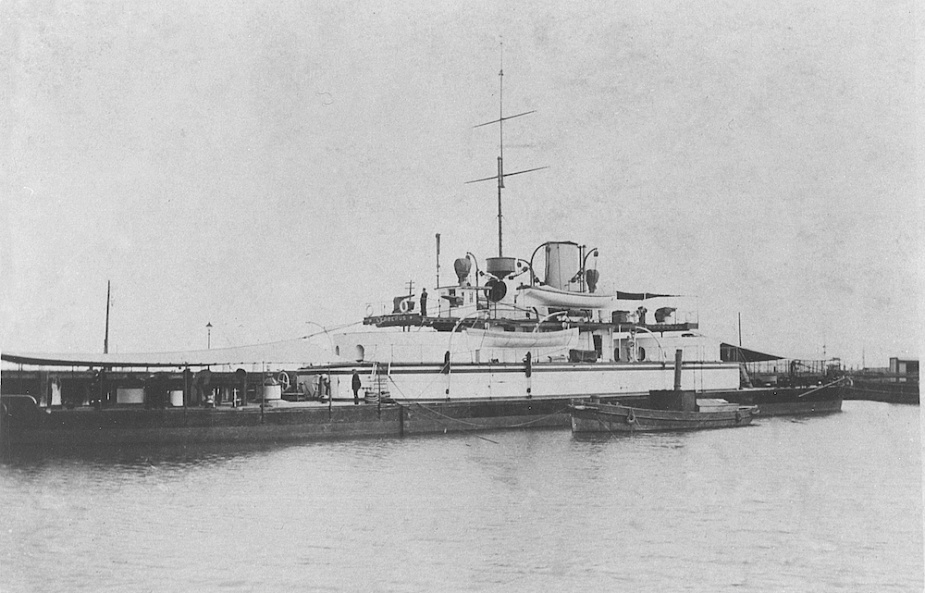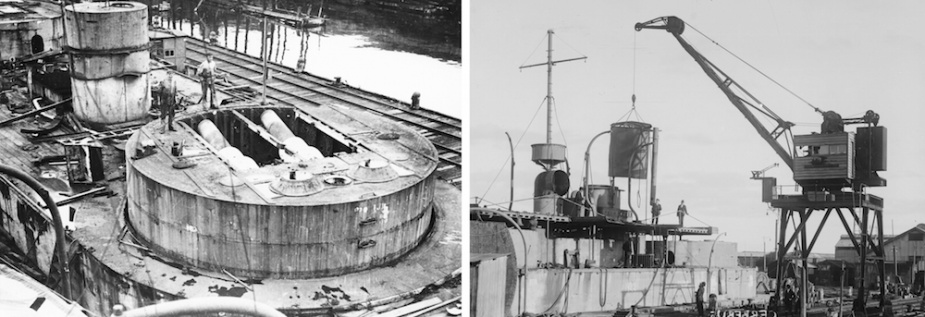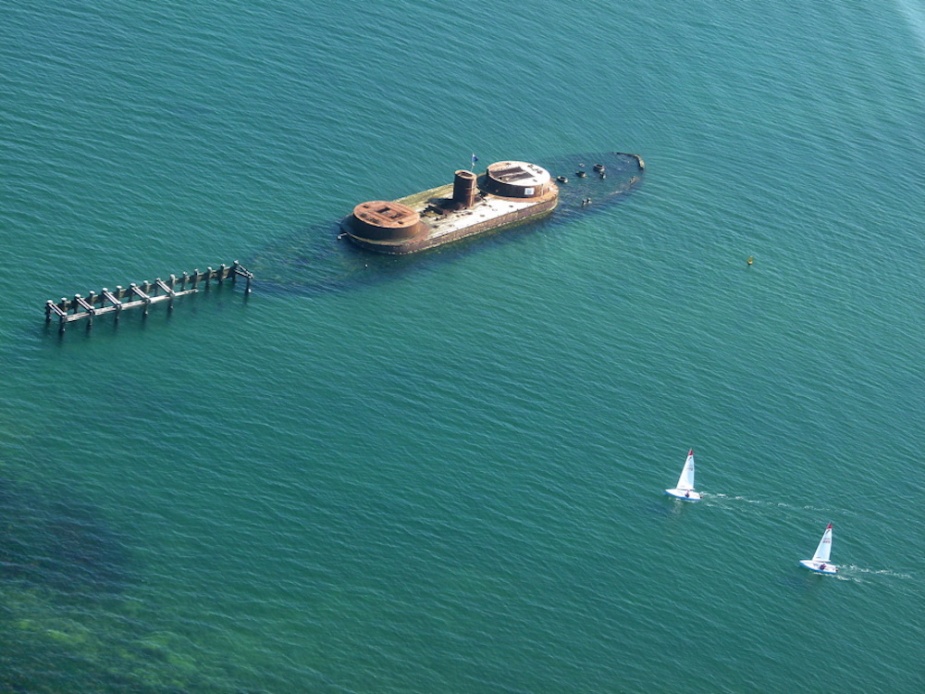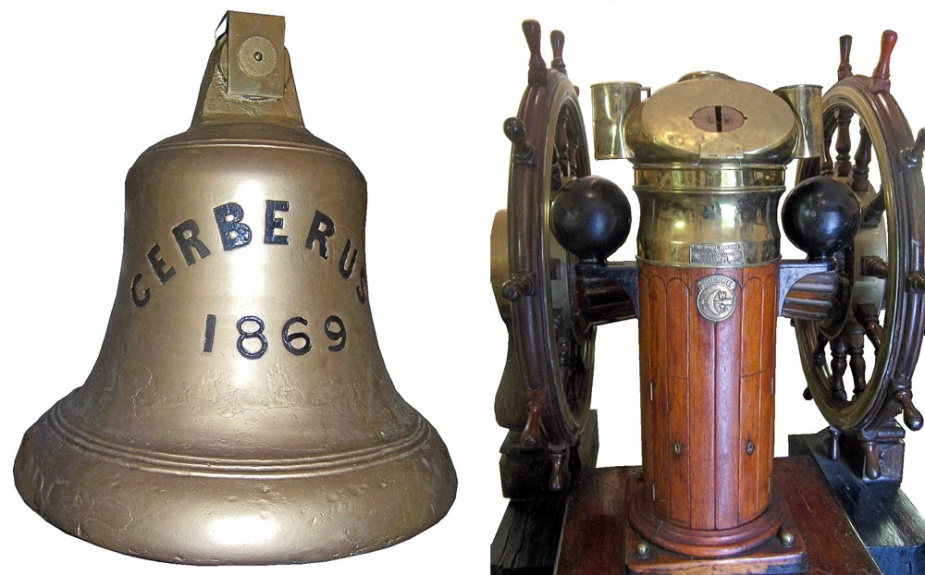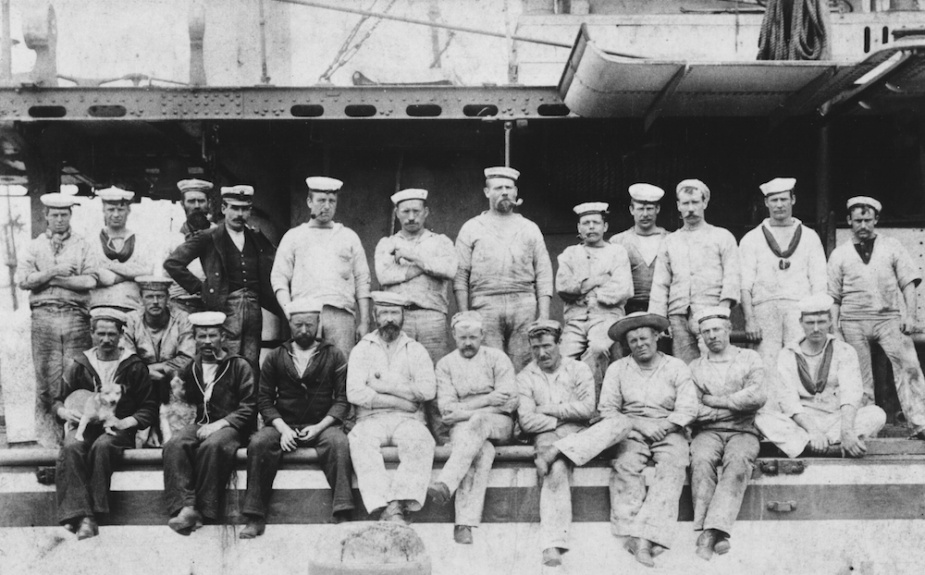HMAS Cerberus (HMVS)
| Type |
Coastal Defence Turret Ship/Ironclad Breastwork Monitor |
|---|---|
| Builder |
Palmer Shipbuilding & Iron Co |
| Laid Down |
1 September 1867 |
| Launched |
1 December 1869 |
| Commissioned |
April 1871 |
| Decommissioned |
April 1921 |
| Fate |
Sold April 1924 and scuttled as a breakwater at Black Rock, Victoria 2 September 1926 |
| Dimensions & Displacement | |
| Displacement | 3340 tons |
| Performance | |
| Speed | 9 knots |
| Complement | |
| Crew | 82 (normal) up to 155 |
| Propulsion | |
| Machinery | 2 x Maudsley, Son & Field steam engines |
| Horsepower | 250 |
| Armament | |
| Guns |
|
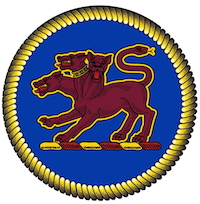
The passing of the Colonial Naval Defence Act, 1865 empowered the Australian colonies to officially acquire warships and to raise and maintain seamen to serve in such vessels.
Of all the Australian colonies, Victoria put the most effort into her naval defences and in 1866 its colonial government applied to the British Government for assistance in establishing a naval force under the provisions of the 1865 Act. In reply to the request the Imperial Government agreed to assist with a grant of £100,000 towards the cost of a monitor turret ship and to donate, as a training ship, the old wooden man-o-war Nelson. The maintenance and manning of the new turret ship would be the responsibility of the Victorian Government, with assistance from the Royal Navy; however, she was to be placed at the disposal of the Commanding Officer of the Royal Navy’s Australia Station in the event of a war.
The ship’s design was comparatively new, the first of its type having emerged just five years earlier during the American Civil War in the form of USS Monitor, and was especially suited to the conditions likely to be encountered in Port Phillip Bay. She would be clad in iron armour up to eight inches thick and, by flooding her ballast tanks with up to 500 tons of water; the ship could lower herself three feet into the water so that only the breastwork and turrets remained on the surface. The design also featured a broad flat bottom, which did nothing to increase her sea-keeping capabilities.
Construction commenced on 1 September 1867 at the Palmer Shipbuilding & Iron Company shipyards at Jarrow-on-Tyne near Newcastle, England, and was completed two years later. The ship commissioned as Her Majesty’s Victorian Ship (HMVS) Cerberus, named after the three-headed hound in Greek and Roman mythology which guarded the gates to the Underworld.
Cerberus was steam powered and although not designed to have masts or sails, these were temporarily fitted to help conserve her coal supply on her maiden voyage to Australia. In her normal configuration, without the mass of rigging required for sails, her guns enjoyed a wide, unhampered firing arc.
Cerberus sailed from Chatham on 29 October 1870 under the Red Ensign and was manned by a crew of twenty-five merchant seamen under the command of Lieutenant William Henry Panter, RN. Panter had been serving in Australia aboard HMVS Nelson and had arrived in his native England in June to take command of the new monitor.
At the beginning of her long delivery voyage to Australia, Cerberus encountered heavy weather as she departed Chatham and was forced to seek shelter at Spithead, between Portsmouth and the Isle of Wight, before continuing on to Plymouth, where most of the crew deserted. With a new crew of sixty-five embarked, the voyage resumed on 7 November. She encountered more heavy weather in the Bay of Biscay but made Gibraltar safely where still more of her crew deserted. Between Gibraltar and Malta Cerberus encountered more favourable weather, and then endured searing heat as she steamed through the Red Sea. On 3 January 1871, the engineer recorded temperatures of 53ºC in the engine room and 61ºC in the stokehold.
After stopping at Aden for coal she continued on to Ceylon and Batavia before encountering cyclonic weather and strong headwinds. She coaled again at Fremantle during the final leg of the voyage where:
...the vessel created a great sensation, and every possible civility was offered by the Government. Governor Weld himself came on board and inspected the ship.
A stay of eight days in King George’s Sound, Albany, was spent taking on additional coal, cleaning and painting in preparation for the passage across the Great Australian Bight and her ultimate arrival at Melbourne.
On Sunday 9 April 1871, having spent 123 days en route, Cerberus arrived in Port Philip Bay. The Melbourne Age recorded:
…the circumstances of her voyage of five months and nine days have been watched with the deepest interest on both sides of the world. Captain Panter expected that it would be the end of April before the ardently hoped-for moment would come when he would drop his ‘mud hook’ off Williamstown; but his skill, together with comparatively favourable weather, has thus materially shortened the voyage.
She was first sighted off Cape Northumberland on Good Friday, but the telegraph offices were closed and it was not till Saturday that the public heard of a ‘turreted ship’ being seen off our coast. Later in that afternoon came the welcome news that the Cerberus had signalled the Cape Otway lighthouse, and yesterday morning she entered the Heads and steamed to her anchorage, which was the berth lately vacated by HM Corvette Blanche.
As she came up she excited the greatest possible interest. As might be expected, she was not regarded as a handsome ship by any means. She appeared, as in great measure she is, a huge, long, square box, cut down straight at both ends, and surmounted by stunted masts, the tops of her turrets and her funnel. This is not the shape she will be when she is stripped of her surroundings. Then she will be a monitor, whose deck line will be 3 feet above the water, save in the centre, where the outline is broken by a breastwork of immense strength, above which are two cupolas and a pilot house, covered with the strongest armour plate. But now, this has been built over with iron bulwarks and a temporary upper deck to enable her to stand the voyage, and her outline is consequently of the ugliest.
The bay seemed all-alive as she entered Hobson’s Bay, and she was the centre of observation. The Russian man-of-war the Haydamack dipped ensign to her and Captain Koltovsky hurried on board Cerberus to pay his compliments to her commander. The boys of HMVS Nelson crowded into the rigging of their ship, and made the air ring again with peals of boyish cheers; and nearly every vessel in the bay hastened to pay the compliment of dipping colours.
Precisely at 1 o’clock the long-wished for moment arrived, and Captain Panter dropped his ‘mud hook’, and the event was immediately celebrated with the frothing of champagne by him and the few friends already onboard, amongst whom was Captain Payne, the chief harbour-master, who had boarded the Cerberus long before.
In the meantime a great multitude of boats, crowded with passengers, had put off from shore in hope of their being allowed on board. In this respect, Captain Panter did not think it right to disappoint the curious public, although the ship was not fit to be seen. He gave the required leave, and then started off to pay his respects to the Governor. During the whole of the afternoon the crowd of visitors increased greatly, and several thousands of visitors must have come on board and endeavoured to understand her construction and the working of the turrets.
Soon after her arrival, Cerberus was docked in the Alfred Graving Dock where her ocean-passage configuration was removed and her conversion to a monitor completed.
The arrival of Cerberus in the Victorian colony saw it briefly possess the most powerful warship on the Australasian station and naturally enough the Victorians were keen to show off their new acquisition. With her merchant crew discharged and with a new crew of naval reservists embarked she began her first trials on Port Phillip Bay on 25 August 1871. It was soon discovered that Cerberus’ guns were too powerful to be fired close to shore following a raft of public protests concerning general damage suffered to windows from the percussive effects of her main armament.
During the 1870s, regular exercises were held with other Victorian naval ships, including the screw battleship, HMVS Nelson, torpedo boats, and the steam sloop Victoria. For more than 50 years, Cerberus was a familiar sight at Williamstown and in Port Phillip Bay where she spent her entire commission.
On 5 March 1881, Cerberus suffered her only casualties when a mine exploded in the water off Queenscliff during exercises, killing the ship’s gunner and five seamen.
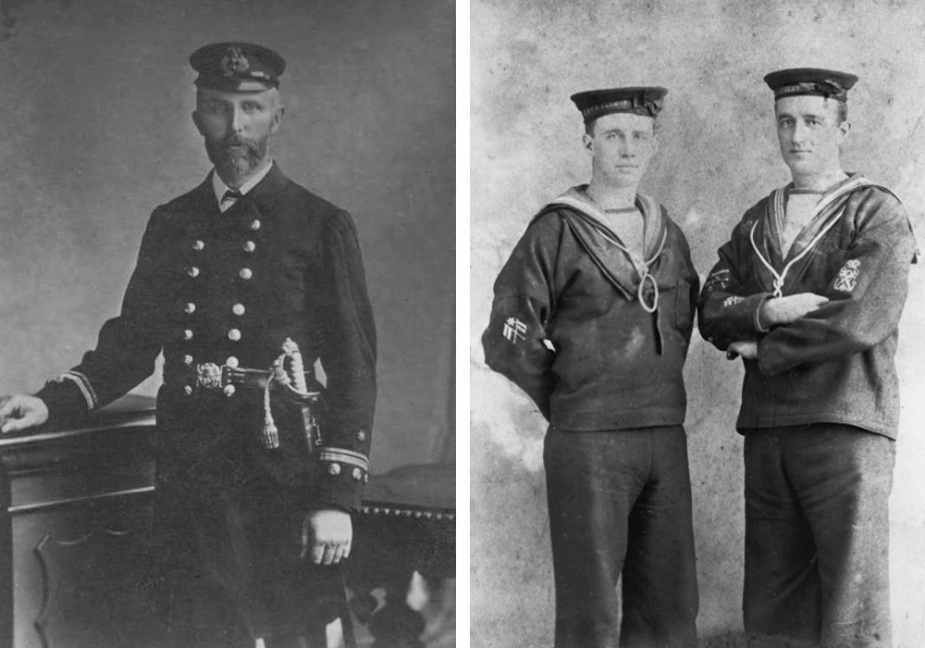
Following Federation in 1901, the individual colonial navies were combined under one administration and became the Commonwealth Naval Forces, though the former colonial navies and their ships, including Cerberus, remained in their local ports. On 1 July 1911, the Commonwealth Naval Forces was formally granted the title Royal Australian Navy (RAN) and the Navy’s commissioned ships henceforth carried the prefix ‘HMAS’.
At the outbreak of war in August 1914, HMAS Cerberus assumed the role of Port Guard Ship for the Port of Melbourne acting as a base for the naval dock guards and small craft patrolling the harbour. She became a store for ammunition and explosives in the later stages of the war.
In 1921, Cerberus was moved from Williamstown to Geelong where, for the next two years, she acted as a submarine depot ship for the RAN’s flotilla of six J-class submarines. On 1 April 1921, her name was changed to HMAS Platypus (II).
In April 1924 she was sold as scrap to the Melbourne Salvage Co Pty Ltd, for the sum of £409, and she was towed back to Williamstown where she was stripped of all her valuable metals and useful fittings.
In 1926, the hull was purchased by the Sandringham Municipal Council, filled with concrete and, on 2 September of that year, was towed across Port Phillip Bay to be sunk at Black Rock, where she remains as a breakwater.
SUNK AT BLACKROCK. BREAKWATER FOR SMALL CRAFT.
The Argus September 3 1926
Yesterday morning the hulk of the old iron-clad Cerberus was towed from her berth at the Williamstown pier, where everything of value had been removed from her, and sunk off the Black Rock jetty to form a breakwater for the yachts and fishing boats. Although the ultimate fate of the Cerberus was decided some time ago, when the Black Rock Yacht Club purchased it for £150 and resold it for the same amount to the muncipal council under agreement that it should be used as a breakwater. the date of the final move was indefinite. This was because the vice-president of the Marine Board (Mr George Kermode), under whose direction the vessel was sunk, did not wish to carry out the somewhat difficult task until the opportunity afforded by the perfect weather conditions presented itself. For this reason the sight of the strange flotilla that appeared off Half Moon Bay shortly after 9 o'clock took residents somewhat by surprise. The word, however, was passed around swiftly, and soon the cliffs were thronged by interested spectators, who saw approaching the grey, squat hull, towed by the tugs Agnes and Minah, and preceded by the Plover and motor-boat to mark the mooring. By 10 o'clock what was left of the Cerberus had been towed and coaxed by the tugs to within 400 yards off the jetty, where her bow was made fast to the existing breakwater, and the stern was slowly swung into position and secured to a temporary mooring. The operation had been timed for high water, when there is a depth of 15ft on the bank selected for the breakwater, and it was estimated that the Cerberus was drawing nearly 14ft. Immediately the hull was made fast three seacocks were opened, and the flooding of the vessel began. Dingys put off from the jetty, and the harbour master's motor-boat took off a large crowd of small boys who swarmed over the decks and down below to watch the rising water. The Cerberus sank almost imperceptibly, going down slightly by the stern. There was a large amount of scrap iron and odds and ends of useless gear, and visitors took away weighty bolts and nuts as souvenirs, after peeping into the turrets to inspect the heavy rusting guns.
The name Cerberus is perpetuated in the RAN’s premier training establishment, HMAS Cerberus, situated at Westernport, Victoria. The present Cerberus has in its museum several heritage items from Cerberus (I) including the binnacle, ship's bell, helm and searchlight.


